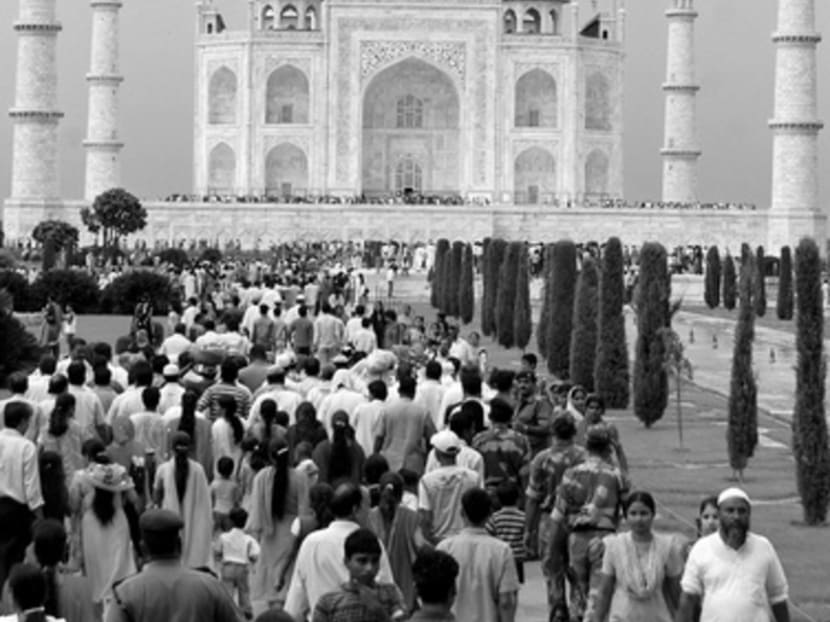Can India’s new visa policy boost tourist arrivals?
What is the relationship between the number of tourists who visit a country and its visa policy? Some excellent data on this question will soon become available from India, which recently rolled out a new visa-on-arrival policy for citizens of 43 countries, including the United States.

Tourists visiting the historic Taj Mahal. Prospective travellers to India can now apply for a visa up to four days before they arrive and are able to stay for as long as a month. PHOTO: REUTERS
What is the relationship between the number of tourists who visit a country and its visa policy? Some excellent data on this question will soon become available from India, which recently rolled out a new visa-on-arrival policy for citizens of 43 countries, including the United States.
The new ruling is a long-awaited and much-needed one. India currently accounts for a measly 0.8 per cent of foreign tourist arrivals in the world, or just under seven million people last year.
That suggests that the kind of foreign direct investment it really needs is more from individual tourists than from big multinationals such as Wal-Mart.
Notwithstanding the well-known challenges of an Indian vacation, it has long been suspected by Indians that what has really deterred tourists from an encounter with the world’s greatest, most hospitable, most spiritually-advanced civilisation is not the extreme heat (or cold, depending on where you go), or the poverty, frenzy, dust, traffic and pollution.
Neither is it the bad roads, slow trains, perplexing hotels, babel of languages or ever-present spectre of Delhi belly, nor the crowds of people wanting to take your picture, or have their picture taken with you, or your address for their own visa applications to the West.
Nor is it the hordes of touts all wanting your custom or the urchins your change, just because you are white or wore shorts despite being able to afford long pants and so must, therefore, be rich.
No, the hardest thing about visiting India was probably just getting past the red tape of bureaucracy into the damn country. Generations of determined tourists have lamented the long lines at foreign missions with (as with India itself) no apparent rules or signs, the complicated forms and the absurdly long processing times, the grim clerks using only two fingers to type, but able to conduct extremely detailed, if pointless, cross-examinations (“Madam, you were married? Then divorced?”).
And at every step of the process, the uneasy sense that something could go terribly, terribly wrong and while it would not be your fault, it would not be anybody else’s fault, either.
The new policy, while not perfect or unambiguous — what, exactly, is a “casual business visit” and what might one do on such a trip that would break the compact of casualness? — promises to bring an end to most of those hassles.
But at least the application process is all online and it involves none of the visits to Indian missions abroad and the long processing times that so frustrated foreign travellers in the past.
Prospective travellers can now apply for a visa up to four days before they arrive and are able to stay for as long as a month: Long enough for large infusions of kebabs and culture in New Delhi, a spa retreat in Kerala, a visit to a tiger reserve in Madhya Pradesh, a day trip to the Taj Mahal in Agra, a week on the beaches of Goa or Odisha, expeditions to the cave art of Ajanta and Ellora, walks along the famous waterfront of Varanasi and on Colaba Causeway in Mumbai, ascents into hill stations in Himachal Pradesh and Uttarakhand, descents into the stepwells of Gujarat and Rajasthan.
And we have barely scratched the surface.
WILL NEW POLICY WORK?
This liberalisation of India’s visa regime should in a few years supply enough data to make for a fascinating case study into how visa policy stimulates or suppresses the growth of a country’s travel industry. Here is why.
Over the past decade (during which visa policies have been relatively constant), the number of tourists visiting India has grown at a steady clip, adding 200,000 to 500,000 visitors each year, leaving out the post-recession years of 2008 and 2009.
That is an average annual growth rate of about 5 per cent, on par with the world average.
But should not a vast country with such a grand past and such a remarkable diversity of landscapes, religions and cultures be seeking to make more of its unique appeal?
Could these figures have been much higher if it was easier to get a tourist visa to India? And could the new policy be a catalyst for a higher growth rate?
We may soon be able to find out. After all, one in every seven foreign visitors to India today is American, which means the new ease of access for US travellers could have a considerable effect on tourism.
The new policy also applies to citizens of Germany and Japan, meaning that India has just become much more accessible to people from three of the world’s four largest economies (for many reasons, the policy could not be extended to China).
That is just the sort of boost from the government that the Indian travel industry needs.
This winter, drop all your reservations about India — make some reservations instead. We want you like never before. BLOOMBERG
ABOUT THE AUTHOR:
Chandrahas Choudhury is a novelist based in New Delhi.






